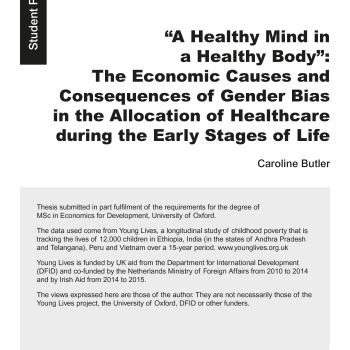Publication Information

The so-called “fetal origins hypothesis” has increased the interest of health economists in the importance of the environment during the first 1,000 days of life following conception. Economists have found growing evidence that the lifelong trajectory of human capital formation is strongly governed by the level of healthcare that children receive during this time period. This paper follows recent literature in asking how gender-biased investments in earlylife healthcare can affect long-term educational outcomes for boys and girls.
Focusing on India, where the Young Lives longitudinal study allows for following a cohort of children over a 12-year period, these data are used to first establish the relationship between early-life health and cognitive development, and then search for potential gender biases in early-life healthcare. Under a certain set of assumptions, and following previous literature on household behaviour in India, the author is able to construct a sample whereby they can identify if the sex of the fetus has likely been determined, thus allowing for potential gender preferences to influence resource allocation decisions. This paper, inclusive of OLS, 2SLS and logit regression analysis, forms a solid case for a differential in educational attainment between the genders driven by early-life healthcare.

The so-called “fetal origins hypothesis” has increased the interest of health economists in the importance of the environment during the first 1,000 days of life following conception. Economists have found growing evidence that the lifelong trajectory of human capital formation is strongly governed by the level of healthcare that children receive during this time period. This paper follows recent literature in asking how gender-biased investments in earlylife healthcare can affect long-term educational outcomes for boys and girls.
Focusing on India, where the Young Lives longitudinal study allows for following a cohort of children over a 12-year period, these data are used to first establish the relationship between early-life health and cognitive development, and then search for potential gender biases in early-life healthcare. Under a certain set of assumptions, and following previous literature on household behaviour in India, the author is able to construct a sample whereby they can identify if the sex of the fetus has likely been determined, thus allowing for potential gender preferences to influence resource allocation decisions. This paper, inclusive of OLS, 2SLS and logit regression analysis, forms a solid case for a differential in educational attainment between the genders driven by early-life healthcare.

